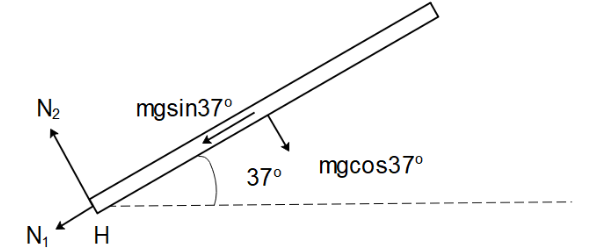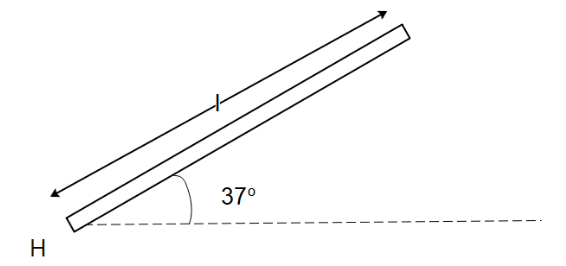Answer
404.7k+ views
Hint : The initial acceleration of the rod can be calculated from the fact that torque that acts on the rod as it rotates will act on the centre of mass of the rod. To find the force exerted by the hinge, we will form a free body of the diagram when the rod is released from rest.
Formula used: In this question, we will use the following formula,
Torque acting on a body: $ \tau = F.r = I\alpha $ where $ F $ is the force acting on the rod, $ r $ is the distance of the centre of mass of the rod from the hinge, $ I $ is the moment of inertia of the rod about its end, and $ \alpha $ is the angular acceleration of the rod.
Complete step by step answer
We’ve been given that a uniform rod of mass $ m $ and length $ l $ is hinged at point H at an initial position of angle $ 37^\circ $ with horizontal. When the rod is released from its initial position, it will fall. We can calculate the torque acting on the rod when it falls as the torque acting on the centre of mass of the rod using the formula:
$ \Rightarrow \tau = F.r = I\alpha $
Since the force that acts on the rod is due to gravity that always acts downwards, we can say that the value of $ F = mg $ . The gravitational force acting on the rod can also be considered as acting on the centre of mass of the rod so $ r = l/2 $ . We know that the moment of inertia of a rod about one of its ends is $ I = \dfrac{{m{l^2}}}{3} $ . Substituting all these values in the above equation, we get
$ \Rightarrow \tau = \dfrac{{mgl}}{2} = \dfrac{{m{l^2}}}{3}\alpha $
Dividing both sides of the equation by $ ml $ , we get
$ \Rightarrow \alpha = \dfrac{{6g}}{{5l}} $
To find the force exerted by the hinge on the rod, let us draw the free body diagram of the system.

The net force that will be exerted by the hinge will be resultant of the forces that act in the direction parallel and perpendicular to the direction of the rod.
For the direction parallel to the rod, since there is no net force, we can write
$ \Rightarrow {N_1} = mg\sin 37^\circ $
$ \Rightarrow {N_1} = \dfrac{{3mg}}{5} $
For the direction perpendicular of the rod, since the pseudo force associated with the acceleration of the rod will act in the direction of $ {N_2} $ we can write the equation of force as
$ \Rightarrow mg\cos \left( {37^\circ } \right) - {N_2} = ma $ .
Here $ a $ is the linear acceleration of the rod that acts on the centre of mass of the rod so we can relate the linear and angular momentum of the rod as $ a = \dfrac{{\alpha l}}{2} = \dfrac{{3g}}{5} $ . So,
$ \Rightarrow \dfrac{{4mg}}{5} - {N_2} = \dfrac{{3mg}}{5} $
This gives us,
$ \Rightarrow {N_2} = \dfrac{{mg}}{5} $
The net force exerted by the hinge on the rod is
$ \Rightarrow N = \sqrt {N_1^2 + N_2^2} $
$ \Rightarrow N = \sqrt {{{\left( {\dfrac{{3mg}}{5}} \right)}^2} + {{\left( {\dfrac{{1mg}}{5}} \right)}^2}} $
On simplifying, we get
$ \Rightarrow N = \sqrt {10} \dfrac{{mg}}{5} $ .
Note
While calculating the torque and the linear acceleration of the rod, we must represent them as acting on the centre of mass of the rod. While making the free body diagram of the rod, it is beneficial to us to make the components of force in the direction parallel and perpendicular to the rod since it will simplify our visualization and calculation.
Formula used: In this question, we will use the following formula,
Torque acting on a body: $ \tau = F.r = I\alpha $ where $ F $ is the force acting on the rod, $ r $ is the distance of the centre of mass of the rod from the hinge, $ I $ is the moment of inertia of the rod about its end, and $ \alpha $ is the angular acceleration of the rod.
Complete step by step answer
We’ve been given that a uniform rod of mass $ m $ and length $ l $ is hinged at point H at an initial position of angle $ 37^\circ $ with horizontal. When the rod is released from its initial position, it will fall. We can calculate the torque acting on the rod when it falls as the torque acting on the centre of mass of the rod using the formula:
$ \Rightarrow \tau = F.r = I\alpha $
Since the force that acts on the rod is due to gravity that always acts downwards, we can say that the value of $ F = mg $ . The gravitational force acting on the rod can also be considered as acting on the centre of mass of the rod so $ r = l/2 $ . We know that the moment of inertia of a rod about one of its ends is $ I = \dfrac{{m{l^2}}}{3} $ . Substituting all these values in the above equation, we get
$ \Rightarrow \tau = \dfrac{{mgl}}{2} = \dfrac{{m{l^2}}}{3}\alpha $
Dividing both sides of the equation by $ ml $ , we get
$ \Rightarrow \alpha = \dfrac{{6g}}{{5l}} $
To find the force exerted by the hinge on the rod, let us draw the free body diagram of the system.

The net force that will be exerted by the hinge will be resultant of the forces that act in the direction parallel and perpendicular to the direction of the rod.
For the direction parallel to the rod, since there is no net force, we can write
$ \Rightarrow {N_1} = mg\sin 37^\circ $
$ \Rightarrow {N_1} = \dfrac{{3mg}}{5} $
For the direction perpendicular of the rod, since the pseudo force associated with the acceleration of the rod will act in the direction of $ {N_2} $ we can write the equation of force as
$ \Rightarrow mg\cos \left( {37^\circ } \right) - {N_2} = ma $ .
Here $ a $ is the linear acceleration of the rod that acts on the centre of mass of the rod so we can relate the linear and angular momentum of the rod as $ a = \dfrac{{\alpha l}}{2} = \dfrac{{3g}}{5} $ . So,
$ \Rightarrow \dfrac{{4mg}}{5} - {N_2} = \dfrac{{3mg}}{5} $
This gives us,
$ \Rightarrow {N_2} = \dfrac{{mg}}{5} $
The net force exerted by the hinge on the rod is
$ \Rightarrow N = \sqrt {N_1^2 + N_2^2} $
$ \Rightarrow N = \sqrt {{{\left( {\dfrac{{3mg}}{5}} \right)}^2} + {{\left( {\dfrac{{1mg}}{5}} \right)}^2}} $
On simplifying, we get
$ \Rightarrow N = \sqrt {10} \dfrac{{mg}}{5} $ .
Note
While calculating the torque and the linear acceleration of the rod, we must represent them as acting on the centre of mass of the rod. While making the free body diagram of the rod, it is beneficial to us to make the components of force in the direction parallel and perpendicular to the rod since it will simplify our visualization and calculation.
Recently Updated Pages
What number is 20 of 400 class 8 maths CBSE

Which one of the following numbers is completely divisible class 8 maths CBSE

What number is 78 of 50 A 32 B 35 C 36 D 39 E 41 class 8 maths CBSE

How many integers are there between 10 and 2 and how class 8 maths CBSE

The 3 is what percent of 12 class 8 maths CBSE

Find the circumference of the circle having radius class 8 maths CBSE

Trending doubts
One cusec is equal to how many liters class 8 maths CBSE

Differentiate between homogeneous and heterogeneous class 12 chemistry CBSE

Which are the Top 10 Largest Countries of the World?

Difference between Prokaryotic cell and Eukaryotic class 11 biology CBSE

Fill the blanks with the suitable prepositions 1 The class 9 english CBSE

Give 10 examples for herbs , shrubs , climbers , creepers

Difference Between Plant Cell and Animal Cell

Change the following sentences into negative and interrogative class 10 english CBSE

Write a letter to the principal requesting him to grant class 10 english CBSE




